With over 2,000 locations in the United States, Panera Bread is one of the most prevalent and popular chains across the nation. Many hail it as an alternative to grease-soaked traditional fast food joints where you can indulge in fresh fruits and veggies all while on a budget. And until 10:30 am, Panera offers a vast selection of breakfast dishes that range from sandwiches, scrambles, bagels, and more. This can be a great option if you’re managing your weight or just looking to follow a healthier lifestyle in the new year. But like all restaurants, not everything at Panera can be considered “healthy,” and there are many indulgent options that shouldn’t be consumed regularly.
Many dishes—as can be seen at a myriad of chain restaurants around the country—may contain added sugar that both enhances flavor and even makes the food look more presentable. But too much added sugar can lead to health concerns such as chronic inflammation, high blood sugar (hypertension), and even the lesser-known non-alcoholic fatty liver disease, it’s important to stay vigilant and check your nutritionals before consuming. And while you are checking out the nutritionals, watch out for too much sodium and saturated fat to support your health.
We do understand that performing a grand assessment of the nutrients provided by each menu item can be hard, especially if you’re standing in a busy line before starting your morning commute. To help you navigate this impressive menu, we’ve gone ahead and sorted through 10 breakfast categories on Panera’s menu, offering an at-a-glance view that shows the “best” and “worst” options in which to indulge.
Sandwiches
Best: Avocado, Egg White, Spinach & Cheese on Multigrain Bagel Flat
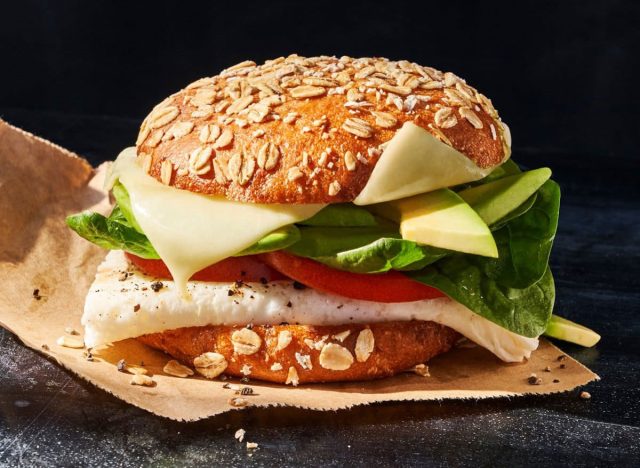
Nutrition: 350 calories, 14 g fat (5 g sat fat), 680 mg sodium, 39 g carbs (5 g fiber, 5 g sugar), 19 g protein
Our top choice for the healthiest Panera sandwich is the Avocado, Egg White, Spinach, and Cheese on their delicious multigrain bagel flat. “I like that this sandwich includes 19 grams of protein, a great amount for breakfast,” says Kacie Barnes, MCN, RD, a Dallas-based registered dietitian. “With tomatoes, avocado, some spinach, and the multigrain bagel, you’ll get some digestion-friendly fiber. It’s much lower in saturated fat than some of the other sandwich options as well.”
Best: Scrambled Egg and Cheese on Brioche
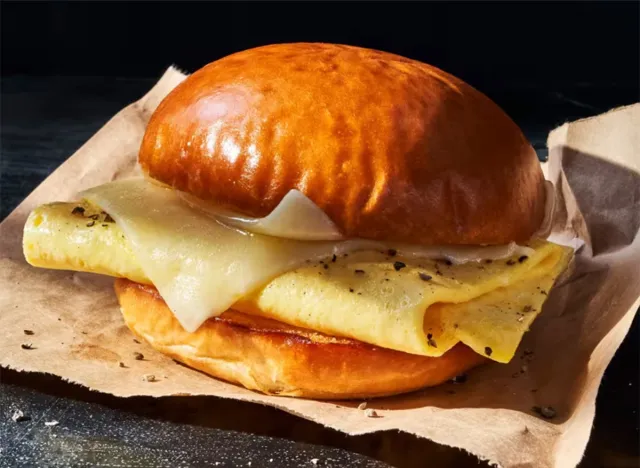
Nutrition: 390 calories, 20 g fat (11 g sat fat), 560 mg sodium, 32 g carbs (2 g fiber, 6 g sugar), 21 g protein
Panera’s Scrambled Egg and Cheese on Brioche sandwich “packs 21 grams of satisfying protein into 390 calories,” says Melissa Mitri, MS, RD Nutrition Writer and Owner of Melissa Mitri Nutrition. The best part about this sandwich is that you can really up your nutritional ante by customizing your order with “extras like spinach to up the fiber, vitamins, minerals, and antioxidants” which will help keep you regular and satiated until it’s time to indulge in your next meal.
Worst: Sausage, Scrambled Egg & Cheese
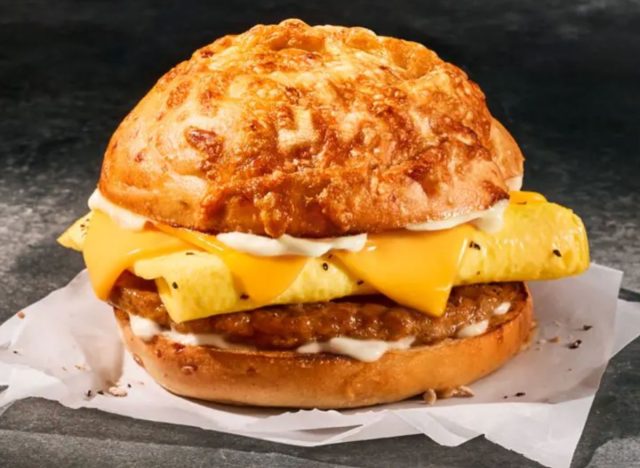
Nutrition: 820 calories, 51 g fat (20 g sat fat), 1300 mg sodium, 58 g carbs (2 g fiber, 5 g sugar), 33 g protein
At 820 calories, this sandwich has the highest calories of all breakfast sandwiches on the list. Of course, we know that calorie count isn’t necessarily an indication of nutritional deficiency, but this sandwich doesn’t tick many nutritional boxes. With 51 grams of fat—and a whopping 20 grams of saturated fat—which far exceeds the American Heart Association’s recommendation of only about 13 grams of saturated fat per day. Believe us, you can find high-protein options elsewhere on the menu.
Worst: Ham, Egg & Cheese on a Cinnamon Cruch Bagel
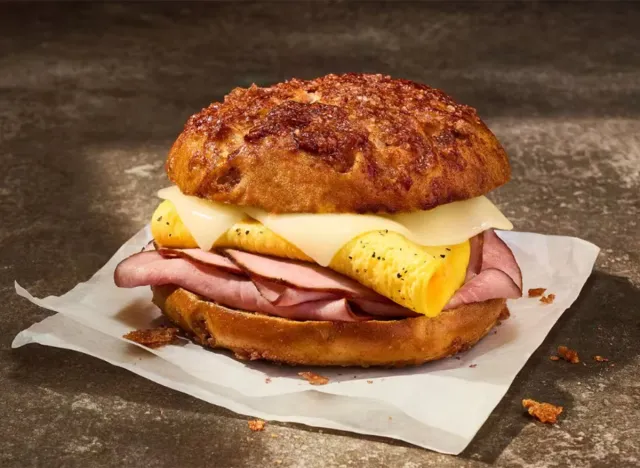
Nutrition: 630 calories, 21 g fat (12 g sat fat), 880 mg sodium, 87 g carbs (2 g fiber, 34 g sugar), 27 g protein
This sandwich which, although doesn’t seem too bad upon first glance, has a whopping “34 grams of sugar, most of which is added. Given only 1 out of 10 Americans consumes the recommended amount of fruits and veggies, this produce-lacking option doesn’t contribute to reaching your daily goals,” says Lauren Harris-Pincus, MS, RDN, founder of NutritionStarringYOU.com and author of The Everything Easy Pre-Diabetes Cookbook. Plus, no one wants to experience the inevitable sugar crash in the middle of the work day.
Baked Egg Souffles
Best: Spinach & Artichoke Souffle
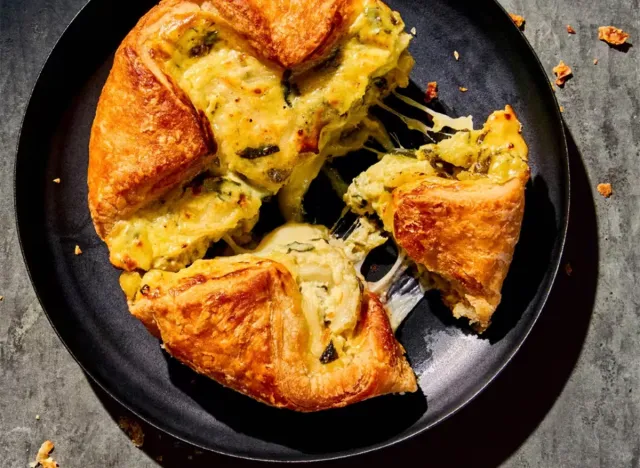
Nutrition: 530 calories, 35 g fat (19 g sat fat), 930 mg sodium, 37 g carbs (3 g fiber, 8 g sugar), 18 g protein
“While this is not the lowest calorie souffle on the menu, it is the most well balanced containing 3 grams of fiber and 18 grams of protein,” says Mitri. It’s important to remember to look at the whole picture when choosing what to eat, and as spinach provides essential nutrients like iron and artichokes are chocked full of antioxidants, this is a truly well-balanced meal.
Worst: Spinach and Bacon Souffle
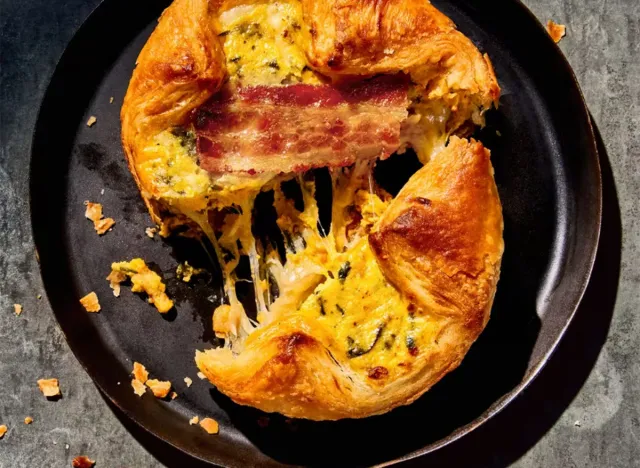
Nutrition: 550 calories, 37 g fat (19 g sat fat), 970 mg sodium, 36 g carbs (1 g fiber, 8 g sugar), 19 g protein
Perhaps unsurprisingly, our unhealthiest choice for egg souffle is the Spinach and Bacon Souffle which contains a whopping 970m grams of sodium. The American Heart Association recommends no more than 1,500m grams of sodium per day for most adults, so this one sandwich almost totally eats up your daily allotment. Too much sodium can lead to cardiovascular disease and even heart attacks, so you really want to keep a close eye on your consumption.
Parfaits, Fruit Cups, and Oatmeal
Best: Greek Yogurt with Mixed Berries Parfait
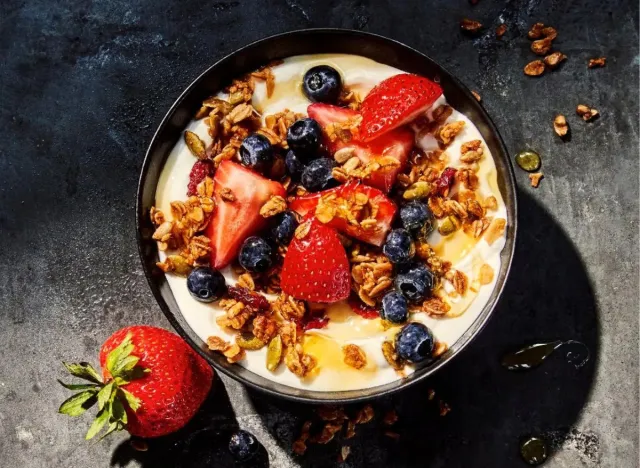
Nutrition: 250 calories, 9 g fat (4.5 g sat fat), 80 mg sodium, 29 g carbs (2 g fiber, 18 g sugar), 16 g protein
“This is a home run breakfast with 19 grams of protein and health-promoting ingredients like nuts and berries,” says Barnes. With 16 grams of protein from the yogurt and naturally occurring sugars from the fruit (don’t let that sugar count scare you), this is a very filling and heart-healthy breakfast option. “I would leave off the honey because it’s sweet enough without it!” continues Barnes, and removing the honey will cut down on your overall calorie counts which can be important if you’re working toward weight loss, specifically.
Worst: Seasonal Fruit Cup
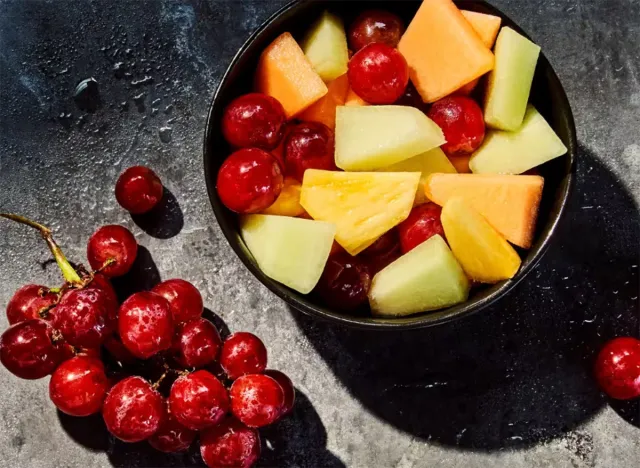
Nutrition: 60 calories, 0 g fat (0 g sat fat), 15 mg sodium, 17 g carbs (1 g fiber, 12 g sugar), 1 g protein
You may be thinking that we’re nuts for this one—fruit is one of the healthiest foods you can eat, right? And yes, it is! However, we want to emphasize that fruit on its own is not exactly a well-balanced meal that will keep you satiated for long periods of time. We recommend that you add fruit to your meal, not make fruit your entire meal. Otherwise, fruit will pass through your system pretty quickly and may even lead to a bit of a sugar crash.
Pastries & Sweets for One
Best: Croissant
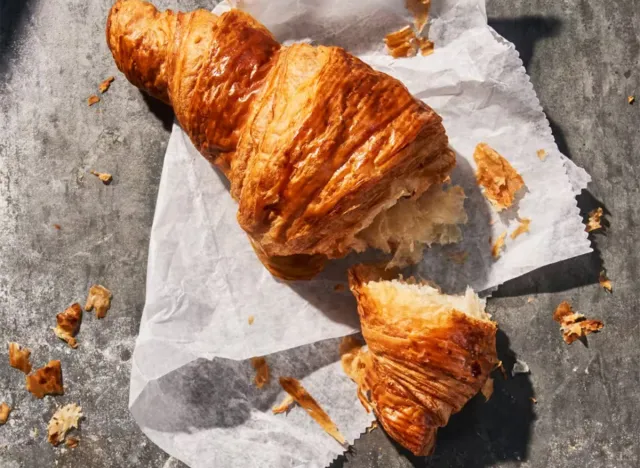
Nutrition: 270 calories, 15 g fat (11 g sat fat), 240 mg sodium, 28 g carbs (1 g fiber, 4 g sugar), 5 g protein
Of course, no one ever said that pastries were what we consider traditionally “healthy.” However, Panera’s classic croissant is the healthiest option on the menu at only 270 calories and 4 grams of sugar. This croissant also boasts 5 grams of protein, so you actually may feel satiated after noshing on this quick-and-easy snack.
Worst: Vanilla Cinnamon Roll
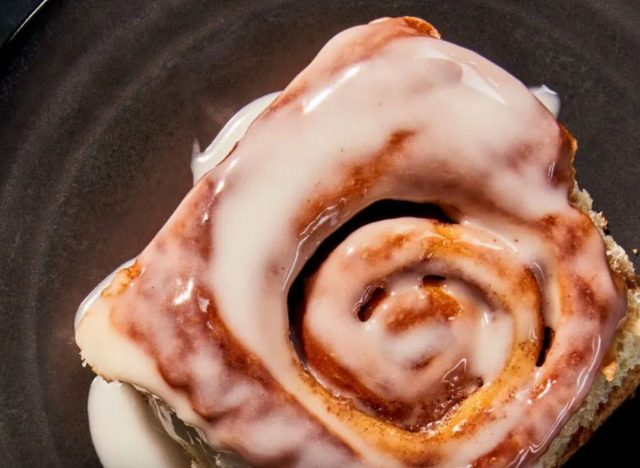
Nutrition: 620 calories, 18 g fat (8 g sat fat), 490 mg sodium, 106 g carbs (1 g fiber, 71 g sugar), 9 g protein
Panera’s Vanilla Cinnamon roll takes the cake in terms of unhealthiest pastry. “This one has extremely high added sugar content with 71 grams of sugar,” says Kacie Barnes, RD, “that’s 284 calories from sugar alone.” Although this cinnamon roll does have 9 grams of protein, the ensuing sugar crash will probably have you feeling like you need a nap. If you do choose to indulge, we recommend that you do so infrequently, as intake of too much added sugar can lead to a slew of health issues including inflammation, cardiovascular disease, and even type-2 diabetes.
Bagels
Best: Multigrain Bagel Flat
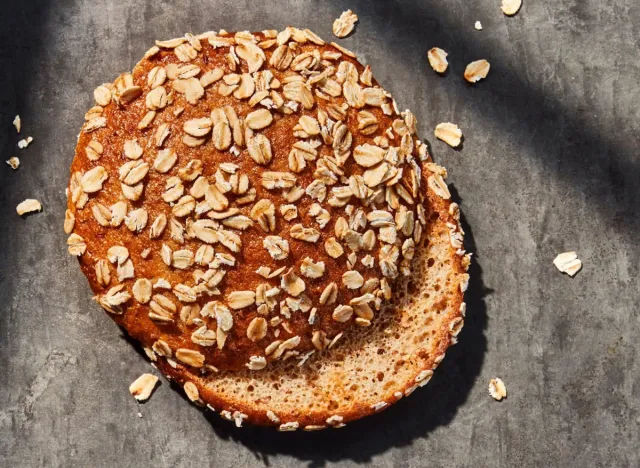
Nutrition: 190 calories, 2.5 g fat (0 g sat fat), 420 mg sodium, 35 g carbs (3 g fiber, 4 g sugar), 7 g protein
No matter what you’re consuming, the key to health is portion control. Portion control is critical for weight management as it reduces obesity risk. Little steps like choosing Panera’s Multigrain Bagel Flat over more doughy varieties can be a great portion control option. This bagel boasts 7 grams of protein and a lower fat and sugar count than many other options.
Worst: Cinnamon Crunch Bagel
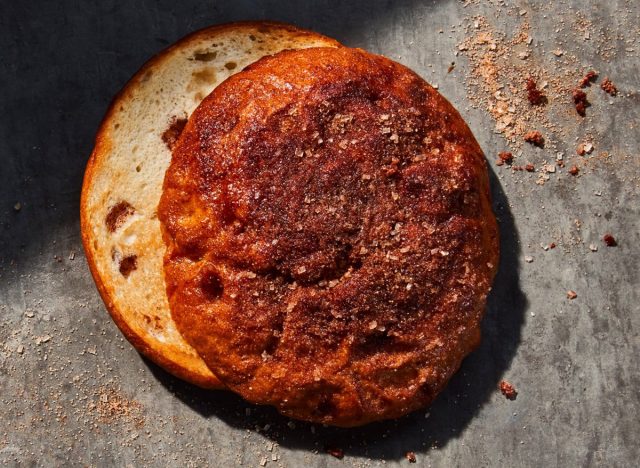
Nutrition: 420 calories, 7 g fat (0 g sat fat), 400 mg sodium, 84 g carbs (2 g fiber, 34 g sugar), 9 g protein
“This [bagel] surprisingly has 2 times the sugar you’d find in a Dunkin Donuts donut, with 34 grams of sugar per bagel,” says Barnes. As per American Heart Association’s guidelines, this one bagel (before you even slather on the toppings), “contains about the maximum amount of added sugar an adult should have in an entire day.” If you do indulge, you’ll probably want to carefully watch your sugar intake for the rest of the day. As that’s no fun for anyone, we recommend it avoiding altogether.
Scones
Best: Mini Blueberry Scone
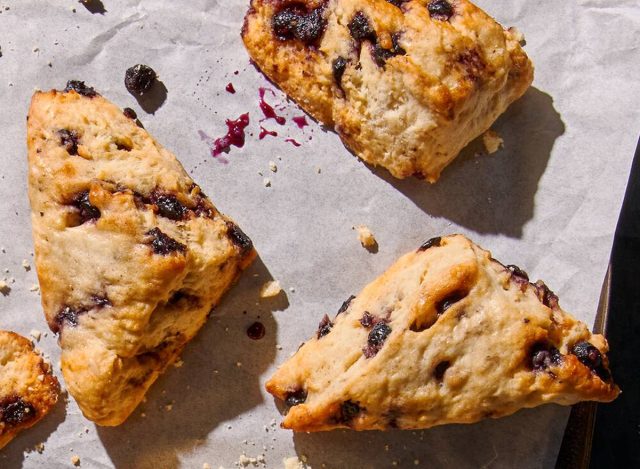
Nutrition: 150 calories, 6 g fat (4 g sat fat), 300 mg sodium, 21 g carbs (1 g fiber, 9 g sugar), 3 g protein
Here’s another great example of where portion control is important. Panera offers both a blueberry and orange scone, and both varieties come in “mini” varieties that are just as satisfying with less than half of the fat and sugars found in the regular sizes. These make great occasional treats to satisfy your sweet tooth without using up your entire recommended daily nutritional limits. Don’t forget to eat a little something else that contains more protein (like eggs) during your breakfast, as this will help keep you full for longer.
Worst: Orange Scone

Nutrition: 550 calories, 20 g fat (13 g sat fat), 810 mg sodium, 80 g carbs (2 g fiber, 38 g sugar), 9 g protein
With 38 grams of sugar, this orange scone takes the cake (no pun intended) in terms of the unhealthiest scone. Although you only have two options—orange and blueberry—this one does have an extra gram of fat and a whopping 12 grams more sugar than the blueberry variety. Yes, this scone does have 9 grams of protein which can help keep you full, but the benefits of this are most certainly canceled out by the sluggishness you’re certain to feel after indulging.
Muffins & Muffies
Best: Chocolate Chip Muffie
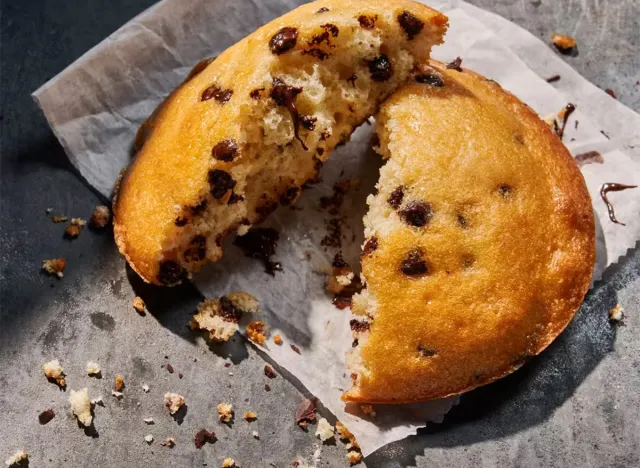
Nutrition: 340 calories, 13 g fat (4.5 g sat fat), 200 mg sodium, 51 g carbs (3 g fiber, 22 g sugar), 5 g protein
The best muffin option at Panera is, by far, their “Muffie” option which, is another term for a muffin-top (which is the best part anyway, right?). The chocolate chip muffin has far fewer calories and nearly half the sugar of their full muffins. Notably, this muffie also contains less than half of the sodium contained in Panera’s muffins—this is important, as too much sodium (which is often inconspicuously found in sweet treats), can lead to multiple health concerns, including high blood pressure and cardiovascular disease.
Worst: Pumpkin Muffin
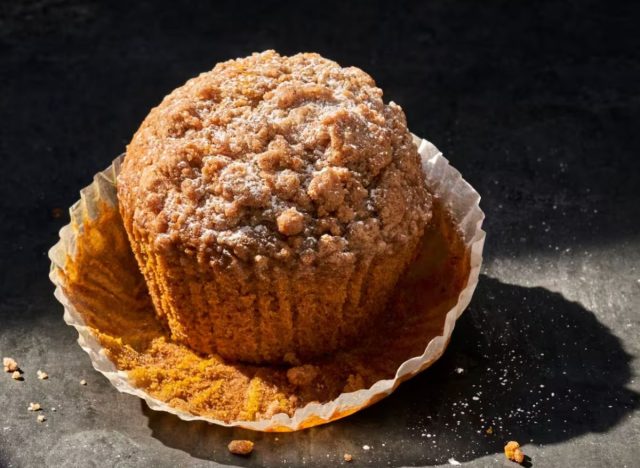
Nutrition: 570 calories, 24 g fat (4.5 g sat fat), 430 mg sodium, 78 g carbs (5 g fiber, 40 g sugar), 8 g protein
This muffin is made with real pumpkin which is a great source of beta-carotene (vitamin A) and antioxidants, yet its health benefits are eclipsed by its excessive sugar and fat counts. This far exceeds the AHA’s recommended 25 grams of sugar per day. And, as Americans are far exceeding this daily limit—according to a 2012 study, Americans are consuming an average of 77 grams per day—this can directly contribute to a slew of health issues if consumed frequently. As always, enjoy with an eye to portion control.
Espresso Bar (Hot)
Best: Hot Americano
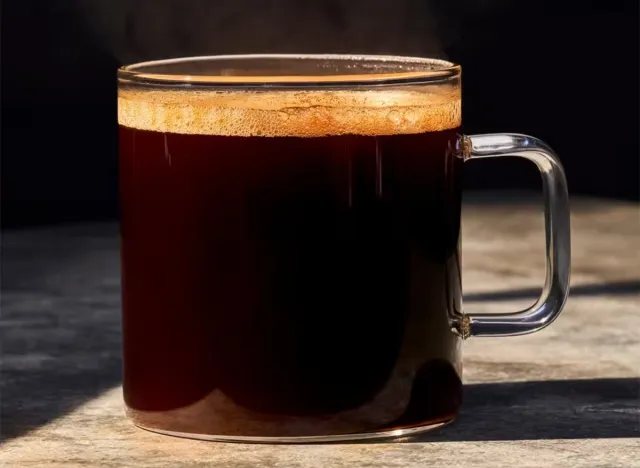
Nutrition: 10 calories, 0 g fat (0 g sat fat), 5 mg sodium, 2 g carbs (0 g fiber, 0 g sugar), 0 g protein
Ah, coffee! What a beautiful smell on a hectic morning. Despite earning a bad rap over time due to coffee’s high caffeine content, coffee has been proven to host a slew of health benefits. A meta-analysis showed a correlation between coffee consumption and a decrease in Alzheimer’s risk while one study review showed a potential correlation between coffee intake and weight management. Of course, these benefits are lessened when you add highly-sweetened coffee creamers to your morning cup. So, we recommend a splash of milk or a non-dairy substitute to get some nutritional bulk without the unnecessary crud.
Worst: Caramel Latte
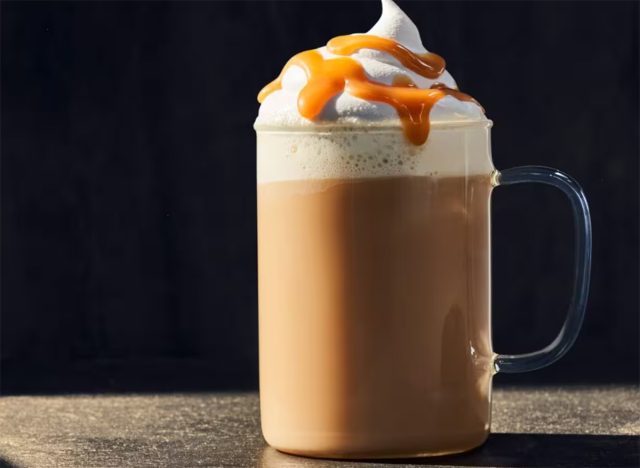
Nutrition: 410 calories, 13 g fat (8 g sat fat), 290 mg sodium, 60 g carbs (0 g fiber, 42 g sugar), 11 g protein
Yep, you read that right—42 grams of sugar for one latte. Instead of consuming something that could keep you full and satiated until your next meal, indulging in one of these drinks doubly exceeds your daily recommended sugar limits as well as 20% of your daily caloric needs if following a 2,000-calorie-per-day lifestyle. This drink offers no fiber, either, but does consist of over half your daily saturated fat limit. Need a little sweetness? Add some naturally-occurring sweeteners like Stevia to your morning cup of Joe.
Espresso Bar (Cold)
Best: Iced Caffe Latte
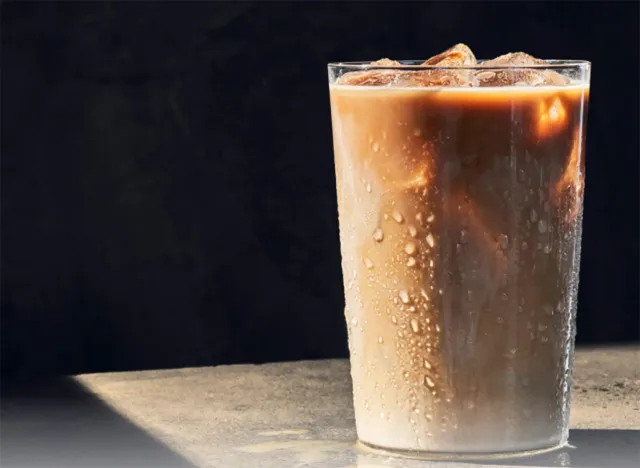
Nutrition: 160 calories, 6 g fat (4 g sat fat), 130 mg sodium, 16 g carbs (0 g fiber, 14 g sugar), 11 g protein
Panera’s Iced Caffe Latte is the best option out of all their cold espresso bar options as it boasts the fewest calories, fat, and sugar all while still providing 11 grams of protein from the milk. The only ingredients in this drink are reduced-fat milk and espresso, so you can rest assured that you’re not getting a whole lot of empty nutritionals that you didn’t sign up for. If you have an intolerance or allergy, you can easily substitute dairy milk for a plant-based alternative.
Worst: Frozen Caramel Cold Brew
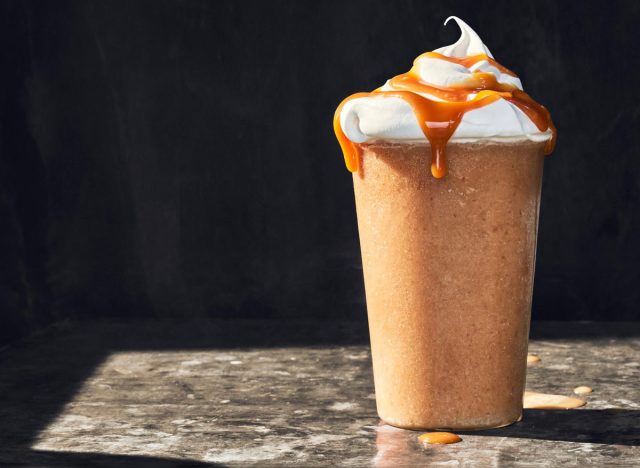
Nutrition: 490 calories, 17 g fat (10 g sat fat), 230 mg sodium, 80 g carbs (0 g fiber, 58 g sugar), 5 g protein
With a whopping 58 grams of sugar and only 5 grams of protein, Panera’s Frozen Caramel Cold Brew is our top contender for the unhealthiest iced drink at the espresso bar. This frozen drink features caramel syrup, a caramel drizzle, and whipped cream so that it resembles a milkshake more than a morning cup of coffee. With so much sugar, these drinks can easily become addictive, so make sure to only indulge occasionally—and maybe even hold the whipped cream and caramel drizzle to save on a sweetness overload.









